Lake McConaughy is a pristine reservoir in Keith County, Nebraska. As Nebraska’s largest reservoir, it’s a favored destination for outdoor fun. From its white, sandy beaches to its trophy-sized fish, Lake McConaughy offers 35,700 surface acres of water to enjoy. Discover all of Lake McConaughy’s features, including fishing, size, depth, and more.
Where Is Lake McConaughy Located?

Lake McConaughy is just nine miles north of Ogallala, Nebraska.
©marekuliasz/Shutterstock.com
Occupying the southwestern part of the state, Lake McConaughy isn’t too far from the Colorado border. Located in Keith County, Nebraska, Lake McConaughy is just nine miles north of Ogallala. It is also situated between U.S. Highway 26 and Nebraska Highway 92, making it easy to access. Visitors from Colorado, Wyoming, and Kansas also frequent this popular reservoir, as it is a relatively close and easy drive.
How Big Is Lake McConaughy?
Lake McConaughy is 35,700 acres in size. It is 22 miles at its longest points and has a maximum width of four miles. Lake McConaughy is also 142 feet in depth at its deepest point. When the reservoir is at full capacity, it holds 1,740,000 acre-feet of water.
Lake McConaughy is also encircled by 76 miles of shoreline with many beach spots for swimming. Because Lake McConaughy is the largest reservoir in Nebraska, it’s earned the nickname “Big Mac.”
The History of the Lake
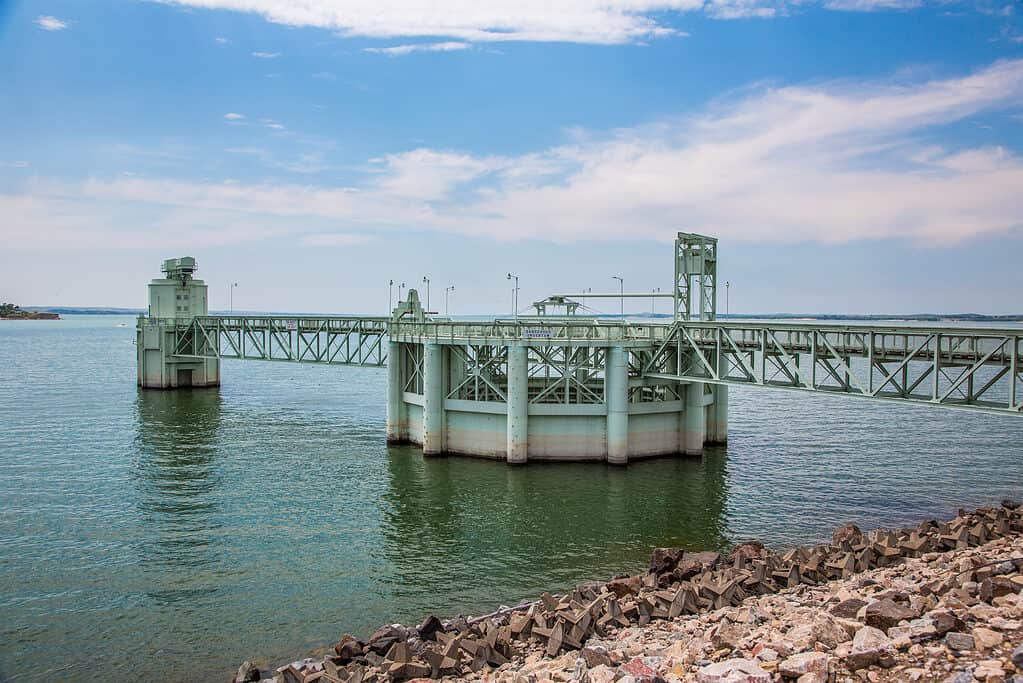
The Central Nebraska Public Power and Irrigation District (CNPPID) owns and operates the dam, reservoir, and hydropower plant.
©Bob Pool/Shutterstock.com
As a water storage solution for irrigation, the construction of Lake McConaughy was approved as a hydro-irrigation project in 1936. A $43 million endeavor, $19 million was paid for by a PWA grant, and the rest was a federal loan which was paid off in 1995. Besides providing water to cities and farmland during dry periods, this Depression-era project created over 1,500 jobs.
Made to store flows of the North Platte River, the Kingsley Dam was built on the east side of the lake to impede the water, thus forming Lake McConaughy. Kingsley Dam held the title of the second-largest hydraulically filled earthen dam in the world when the Kingsley Dam was completed. The entire dam and reservoir project was finished in 1941. The Kinglsey hydropower plant was added in 1984 in response to the area’s increasing power needs.
The Central Nebraska Public Power and Irrigation District (CNPPID) owns and operates the dam, reservoir, and hydropower plant.
Fishing at Lake McConaughy
With 76 miles of shoreline and a surface area of 35,700 acres of water, Lake McConaughy is the perfect place for sports fishermen. In fact, many of the state record catches were caught in this lake!
As a favored fishing location, Lake McConaughy is a place where you can catch walleye, northern pike, largemouth bass, and more!
Walleye
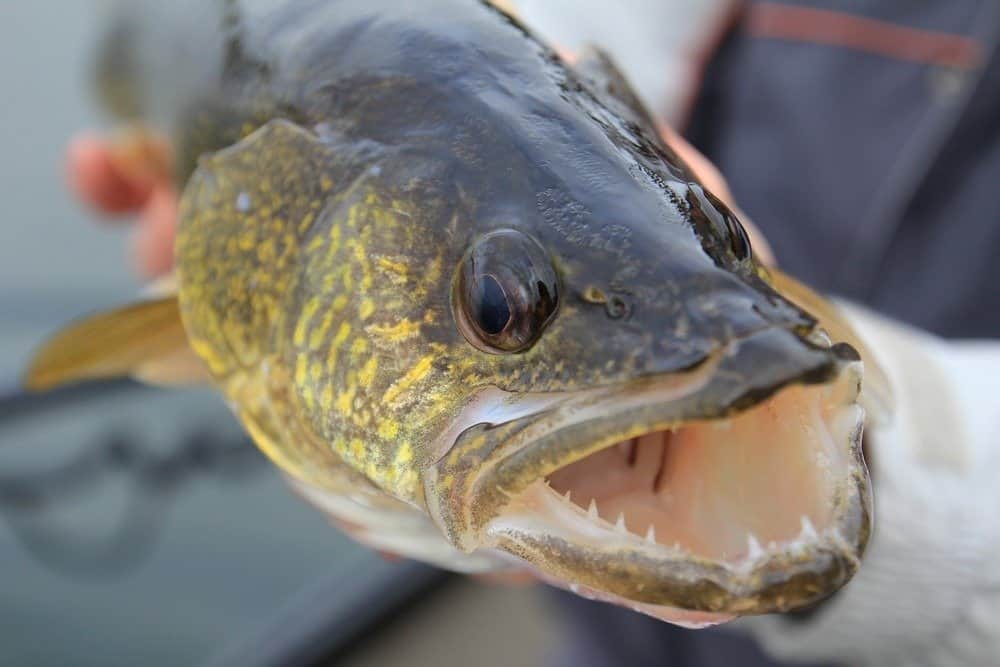
Walleye have incredible hearing and taste buds on their lips and face, making them tricky to catch.
©ElvK/Shutterstock.com
Named for their cloudy-looking eyes, the pearlescent effect is due to the tapetum lucidum tissue behind the retina. This acts as a retroreflector, which reflects light back through the retina. This grants the walleye superior vision in low light, giving them an advantage as predators, especially at dawn and dusk.
Walleye have a light, buttery flavor. It’s also popular among anglers because of the versatile ways you can cook it – whether you grill, pan-fry, or bake walleye. It may be enjoyed in many ways.
However, anglers also relish the challenge of hooking a walleye. These fish have incredible hearing and taste buds on their lips and face, making them tricky to catch. Because of the external tastebuds, they can detect prey without even needing to open their mouths.
The rod and reel Nebraskan record for a walleye is 16 pounds and two ounces, caught by fisherman Herbert Cutshall in 1971. And this walleye was hooked in none other than Lake McConaughy!
Northern Pike
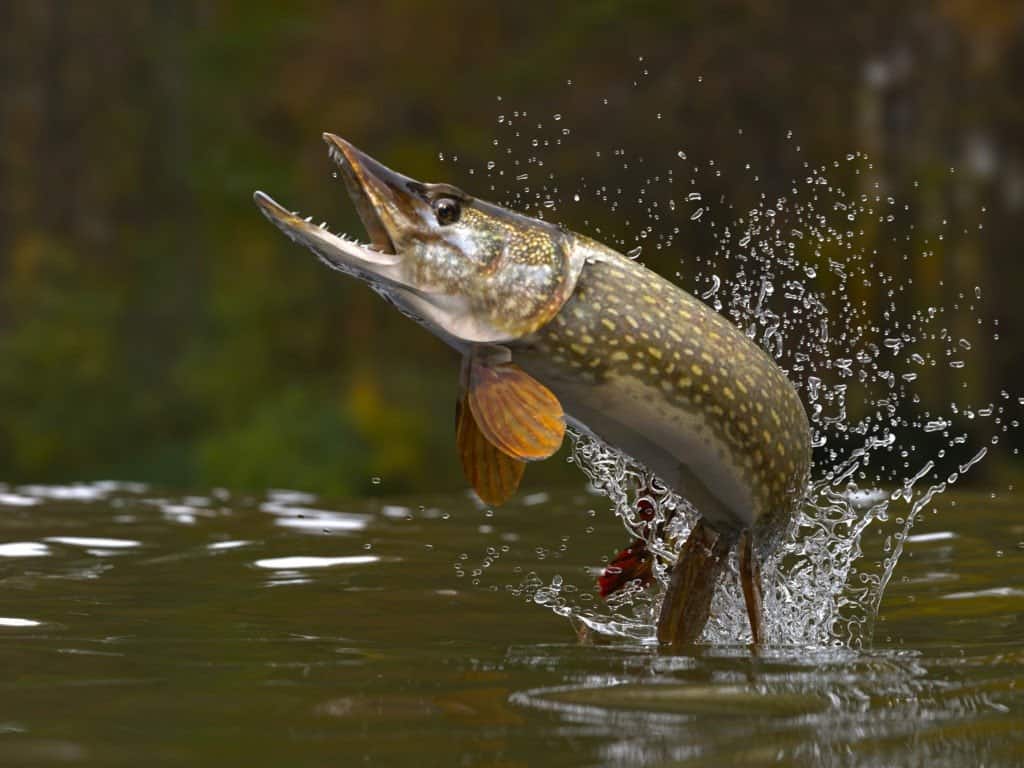
Often growing 10 to 15 inches in its first year of life, a northern pike can reach over four feet long and 40 pounds in weight.
©bekirevren/Shutterstock.com
Usually olive green in color with yellow speckling, a northern pike can be identified by its long, torpedo-shaped body and large yellow eyes. Often growing 10 to 15 inches in its first year of life, a northern pike can reach over four feet long and 40 pounds in weight. As opportunistic predators, the northern pike is at the top of the food chain, eating smaller fish, invertebrates, small mammals, and even birds.
Northern pike keep to slow-moving waters with abundant vegetation. As freshwater fish, you may find northern pike in large lakes, reservoirs, and rivers. They may dwell in waters up to 100 feet deep, making Lake McConaughy an ideal home for northern pike.
Largemouth Bass
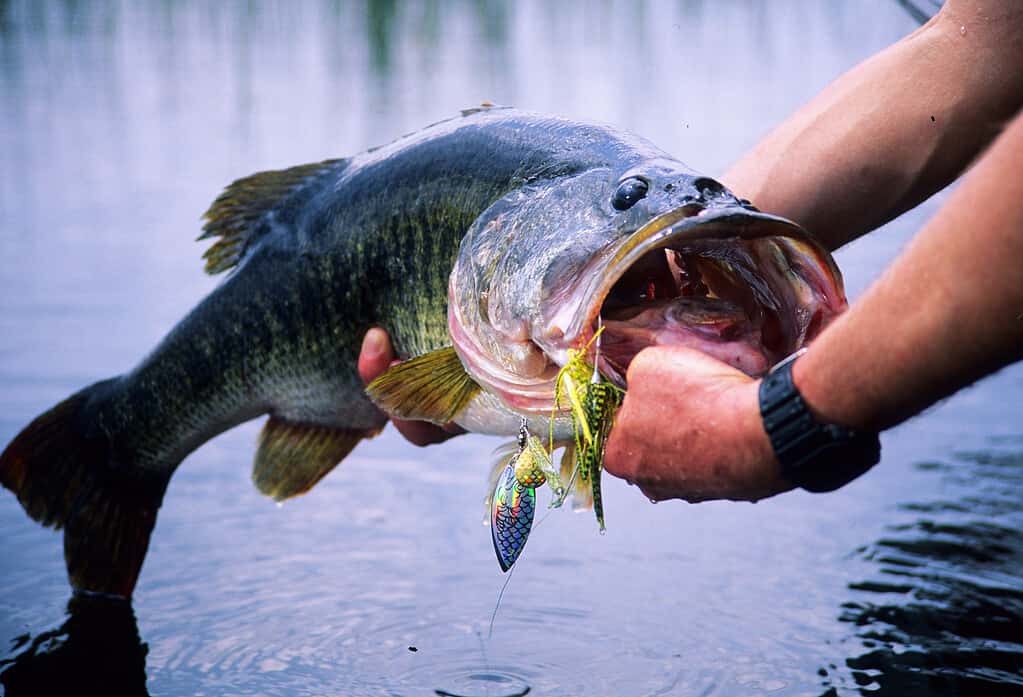
On average, largemouth bass are 12-15 inches long and weigh 12 pounds or more.
©iStock.com/stammphoto
The name of this fish comes from the fact that the corner of its mouth extends past its eye! Ranging in color from forest green to olive, largemouth bass have distinctive bands along the sides of their bodies. While they are a part of the sunfish family, largemouth bass have thicker, less “flattened” bodies compared to most sunfish. And largemouth bass can grow quite large! On average, largemouth bass are 12-15 inches long and weigh 12 pounds or more.
Smallmouth Bass
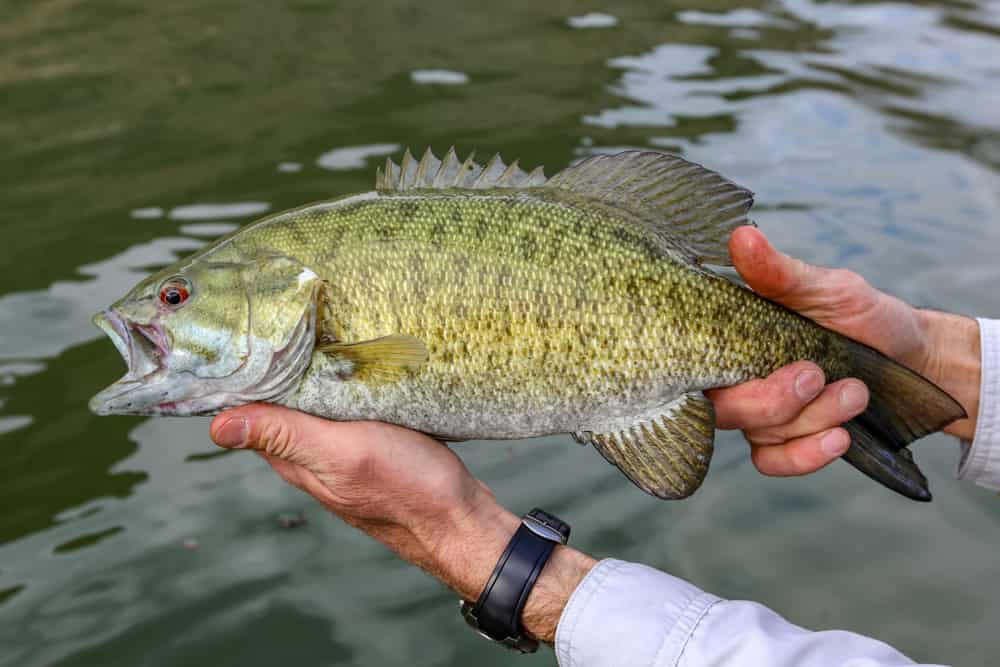
Because smallmouth bass are aggressive and feisty to reel in, it is a popular fish among anglers.
©CSNafzger/Shutterstock.com
These fish have much smaller mouths than the largemouth bass—thus, the name. And depending on their habitat, their coloring ranges from green to golden, with dark bands across the body. Typically, smallmouth bass will grow to be 12-16 inches and weigh three to six pounds.
Because smallmouth bass are aggressive hunters, many types of lure and bait work for hooking this fish. And, because they can be so feisty to reel in, it is a popular fish among anglers. Smallmouth bass are often the apex predator in their habitat and only have to fear bigger bass, northern pikes, and muskies.
Outdoor Recreation at Lake McConaughy
Boating
Many people participate in water recreation on Lake McConaughy, whether that be water skiing and tubing, sail boating, or parasailing. There are outfitters at the lake where you may rent a boat, or you are free to bring your own. Boat ramps are available at locations around the lake, depending on how high the water is.
Check out the water trail map for Lake McConaughy.
Swimming
Lake McConaughy’s white, sandy beaches make for pleasant beach days. Whether swimming, picnicking, or soaking up the sun, Lake McConaughy is a vibrant summer spot. Though it should be noted there are no lifeguards on duty at any of the beach areas.
Walk-in beach areas open during the day may be found near Martin Bay, Arthur Bay, Sandy Beach, and Cedar View entrances. Additionally, there are walk-in entrances at each of the beach camping areas around the lake. However, there is no overnight camping in any non-designated beach camping areas.
Camping
The height of the camping season is between May 20 to September 10, and you may reserve a campground online up to 180 days in advance at Lake McConaughy. From September 11 to May 14, all overnight camping spots are given out on a first-come, first-served basis.
In Conclusion
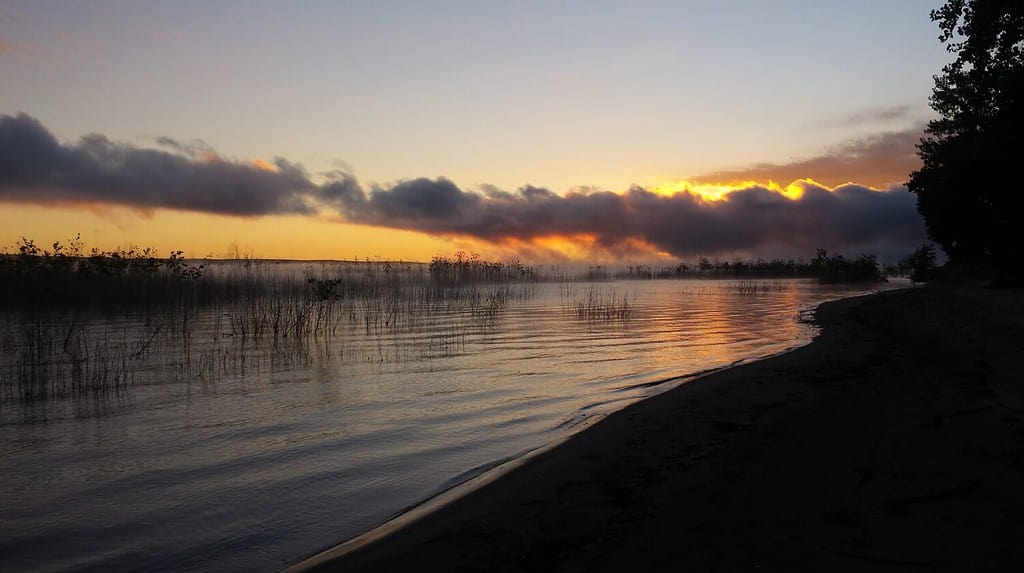
Lake McConaughy’s beaches are a beautiful spot to catch a sunrise.
©RUSSELL TEBBS/Shutterstock.com
Lake McConaughy is certainly a popular destination for summer outdoor fun. Not to mention, it is also a crucial water reservoir for irrigation and hydropower. All in all, “Big Mac” is considered by Nebraskans as a prominent spot for outdoor recreation.
Thank you for reading! Have some feedback for us? Contact the AZ Animals editorial team.







